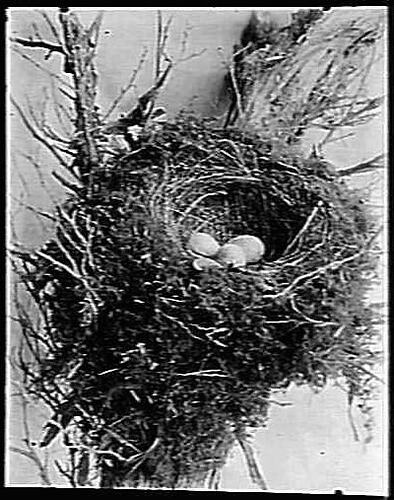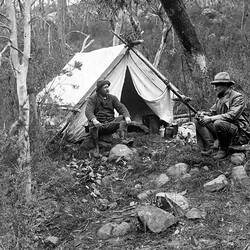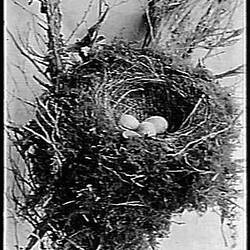GROUND THRUSH (Geocichla Lunulata, Latham)
Geographical Distribution - New South Wales, Victoria, and South Australia.
Nest - Large, open, beautiful; outwardly composted of green moss, dried leaves, grass, etc., matted together with earth or sand; lined inside with a thick ply of grass, sometimes with pieces of rushes and rootlets added. Usually situated on a thick limb or fork of a coastal tea-tree (Leptospermum) or banksia, in a swamp tea-tree (Melaleuca) by a creek, or in a mossy musk or other tree in the mountains, but always sheltered by thick scrub. Dimensions over all, 8 to 10 inches by 5 or 6 inches in depth; egg cavity, 2 ¾ inches across by 2 inches deep.Eggs - Clutch, two to three; true oval in form; texture of shell fine; surface glossy; colour, light warmish-green, spotted and blotched, usually all over, with reddish or rufous-brown, intermingled with cloud-like markings of dull-red. Dimensions in inches of proper clutches: A (1) 1.33 x .9, (2) 1.32 x .92, (3) 1.31 x .92; B (1) 1.29 x .87, (2) 1.28 x .86, (3) 1.24 x .86. (Plate 9).
Observations - The true home of lovable bird is the great forest region and coastal scrubs of South-east Australia. My associations with the Mountain Thrush, or, more strictly speaking, Ground Thrush, have been of the most pleasant and interesting kind; therefore if I have wandered too much into detail in giving my ob-servations on this bird, please skip, and put down to excessive enthusiasm on my part.
The bird may be called Mountain, for it is a lover of the fern gullies and musk-tree thickets of the hilly tracts. But is has been in the tea-tree groves of the coast where I have most cultivated its acquaintance.
On the eastern shore of Port Phillip, after passing St. Kilda, patches of tea-tree (Leptospermum), greater or smaller in extent, occur at intervals until Mordialloc is reached. Here density commences in real earnest, and constitutes almost an unbroken margin to the eastern portion of the bay. In these dense brushed, if carefully sought for, may be seen the Ground Thrush - a timid, modest creature - 'at home'.
In October this great belt of living Leptospermum is a mass of white flowers, so dense that in some sheltered nooks the warm grey foliage and seed cups are barely visible. The aroma from the flowers is like the perfume of new honey.
Lovers of nature, poets, and others, in all lands, usually connect the wedding garment of spring with the nesting of birds. And so it is, as a rule; but the nesting of the Ground Thrush is one of the interesting but not altogether unique exceptions among our Australian birds.
In the bleak and frosty months like July, the Ground Thrush commences to construct its nest, or re-build by making additions to a former old home. In cases where nests are used by the birds season after season, they become a goodly size, and the foundations have a venerable, moss-grown appearance. Some of these favourite old homes measure a foot across, while the actual cup of the nest would only measure half that dimension by two or three inches deep.
A favourite situation for the nest is about twelve feet from the ground in the fork of an upright tree, in the centre of a thick clump or scrub, growing in a hollow or dip between the ancient sand drifts, where about the base of the trees is scattered dead and decaying timber among dwarf and sparingly-grown bracken. Another favourite locality for a nest is on a sand rise, about twenty paces from high-water mark, the nest being placed on a thick horizontal branch hidden with thick foliage; or another site is a darkened spot where the taller tea-tree tops meeting overhead, together with the closely-packed, twiggy, lichen-covered stems, quite subdue the light below. Another nest may be humbly situated within read of hand. Yet again a secure resting-place for a nest may be chosen on a rough bulky limb of a banksia tree, if well protected with crowded tea-tree scrub.
The nests are perfect models of bird architecture, beautify proportioned and tastefully decorated with verdant moss - fit subjects for pictures (see illustration). The eggs also are gems for beauty, being of a delicate light-green, mottled with purplish-red. A triplet of eggs may be found once in every two or three nests, the balance being in pairs.
As stated, the eggs are generally deposited in winter. One wonders how it is possible for the little naked young to survive the raw months. But let a person enter these dense tea-tree scrubs, and he will be astonished at the mildness of the atmosphere there, for the density of the timber and foliage seems to exclude the keenest wind, neither does the frost harden the ground.
Sometimes the earliest birds lay bout the end of June; a few during July. Perhaps about one-fifth of the young are hatched by the end of that month; but from the first to the middle of August the majority of the birds lay.
Although the Ground Thrush is such an early breeder there are exceptions, as with other rules, in its case. Once in the middle of September I saw a nest with three eggs, supposed to be a second clutch or birds previously robbed in the locality, although I do not think they all lay a second time during the season if their nest is interfered with.
Mr. J. Gabriel furnished me with two authenticated notes of late nests with eggs, seen in the Dandenongs. One was towards the end of November, the other 20th December. I also leant of another nest having been taken 9th November, 1893, at Dandenong Creek.
In the young, feathers soon succeed down, and from the nest they assume the same coloured garb as their parents, the prevailing colour of which is olive-brown, darkest on the back and much lighter on the breast and flanks. With the exception of the wings, tail, and centre of abdomen, each feather has a lunar or moon-shaped mark of black at the tip; hence the specific name, lunulata. The beak and feet are horn-coloured, the former yellowish at the gape. The dark-brown eyes are full of meek expression. In fact, the bird's whole contour is captivating, more especially when seen with neck shortened on its moss-bedecked nest, or standing with partly drooping wings over its helpless fledgelings.
With other persons, including Gould, I used to fancy the one drawback in the nature of the Mountain or Ground Thrush was that it was dumb, save a few squeaky nots uttered when alarmed, or when the young was approached, when the bird hurried and flopped over the ground through the scrub, and at the feet of the intruder, making a feeble but sustained hissing whistle. But since. I have learned this Thrush is really a songster, which especially loves to sing 'betwixt the lights' after the sun has gone down. Then the Thrush may be heard in a modest, subdued whistling song, as if to while away the interval of twilight. The music is interspersed with portions of song not unlike that of the English Thrush, but without the full impassioned notes, being a melodious whistle of chiefly two notes, a slide about a third from one to the other, with trills and variations. Sometimes the bird sings at dawn.
Like most true Thrushes, the Ground Thrush loves to feed upon molluscs, but it is not averse to worms. A field observer tole me how he once watched a bird gathering worms, presumably for its young. Pulling a worm out of the ground, the bird would hop silently about with the twisting captive in its bill until another was discovered. Dropping No. 1, No. 2 was hauled from its hole, then No. 1 was again picked up and No. 3 prospected for; and so on, the bird laying down its mouthful each time a fresh capture was to be made, until it had difficulty in keeping together about half-dozen wriggling worms. It would finally fly away with the lot.
The greatest season I experienced amongst the Ground Thrushes was in 1886.
The following are my field notes:-
31st July - Nest in upright tree, fairly thick scrub, in a dip with bracken, dead and decaying logs about. Eggs, two.
14th August - Nest in thick stumpy tree, dense scrub and undergrowth on sandy rise. Eggs, two.
14th August - Nest in stunted tree, dense small scrub on sandy rise near the beach. Eggs, two.
14th August - Among very thick lichen-covered trees near the beach, several growing from one root. Nest on overhanging prong, moss plentiful on ground underneath springing through the dead tea-tree leaves. Eggs, three.
14th August - In straight tree amongst a clump. Nest on underneath limb. Large banksia near tree. Eggs, two.
14th August - In more open but clumpy scrub with thick grass about. Nest eight feet from ground. Eggs, two.
14th August - In overhanging tree in comparatively open scrub; beautiful nest, perfect in shape, edged with pretty moss. Eggs, three.
All the foregoing nests were found after three hours' toiling in and out of a belt of scrub about half-a-mile in extent. The nests varied in height from six t twelve feet above the ground, and with the exception of No. 1, were all found building on the 31st July.
Giving the Thrushes a season's rest, I visited my favour locality again in 1888. Result:-
4th August - Saw fledged young flying with their parents. 4th August - Saw nest building; completed apparently on the 11th, when I took eggs (three), which were slightly incubated. 4th August - Nest in thick low tree. Three eggs partly incubated. 11th August - Nest on overhanging limb. Eggs, three, fresh. 11th August - Saw a nest in overhanging tree, containing three young which were flesh-coloured, with dark or black stripes along centre of back and down wings, with tufts of yellowish down. Birds probably fourteen days old.
All the above nests were in tea-trees.
15th September - Saw Ground Thrush's nest with three eggs. Supposed to be second clutch of birds previously robbed. Heard some birds whistling melodiously at 6.15 p.m., or about twenty-five minutes after sun-down.
Season 1889:-
10th August - Two nests with young about ten days old. Two building in banksias, and a third with one egg. These contained three eggs each on the 24th.
Season 1890:-
2nd August - (1) Visited nest from which I took eggs previous year; contained three fully-fledged young. (2) Found another old nest being renovated; fortnight afterwards contained two eggs. (3) Nest with two fresh eggs. (4) Nest with foundation laid. (5) Nest with two eggs slightly incubated. (6) Nest destroyed by some enemy - bird or beast; one egg remaining. (7) An old nest examined; it contained two eggs on the 16th, when I heard birds whistling as sun was setting.
All these nests were in tea-tree, except No. 5, which was in a banksia.
After another year's respite the haunts of the Ground Thrush were again invaded in 1892 by a party, including Messrs. Le Souëf (three), Mr. R. S. Rogers, my son, and myself, chiefly for the purpose of photographing, in situ, some of the beautiful homes. We found:-
30th July - (1) A nest I had visited two seasons previously contained two eggs half incubated. (2) Nest with fully-fledged young. (3) Nest with two eggs, fresh. (4) Nest with two eggs, half incubated. (5) Nest with three eggs, fresh. (6) Two nests building. Fortnight afterwards (13th August) contained each three eggs. One of these nests made a most successful photograph.
To show how closely in some instances thee various families of Thrushes live to each other, it may be stated that three of the above nests were not more than forty or fifty yards apart, and were situated at points so as form a triangle in the scrub.
I give Mr. Lau's interesting notes of this bird near its northern limit in the sub-tropical scrub of South Queensland, which may be taken as referring to G. heinii:-
'Geocichla lunulate is an inhabitant of the gloomy cedar scrub along the sea coast, resorting near water and always hoping on the ground seeking among the moist debris for its food. Its colour resembles the European Song Thrush. The nest is not unlike that of the (home) Black Bird, and is situated in the first and thick fork of a tree richly bedecked with moss, and the outside covering being formed of the same material. The nest is not so easily detected, and only the bird flying from it betrays the convenient site. The lining consists of rootlets and dark fibre, abundantly to be found in such localities. The eggs also resemble those of the Black Bird. They number two o three - Bunya Mountains, December, 1856.'
An egg in Mr. D. Le Souëf's collection, collected by Mr. Lau, in South Queensland, is inclined to oval; texture fine; surface glossy, colour, pale bluish-white, finely and faintly spotted, thickest on the apex, with chestnut or rufous and dull purplish-brown. It is smaller and not so much marked as those of the southern birds. Dimensions: 1.12 x .79 inches. I venture to say this egg is probably that of G. heinii.
Mr. W. White, of South Australia, sends me a note of having taken a nest of the Ground Thrush on Mount Lofty, which is probably the extreme western limit of the bird's range. I looked in vain for a Ground Thrush in the great timber tracts of Western Australia.
Resources
Transcribed Archibald James Campbell. Nests and Eggs of Australian Birds, including the Geographical Distribution of the Species and Popular Observations Thereon, Pawson & Brailsford, Sheffield, England, 1900. Transcribed from pp. 184-188.
More Information
-
Keywords
-
Authors
-
Contributors
-
Article types


